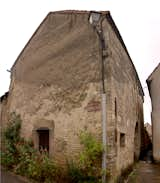How They Pulled It Off: Converting a Medieval Barn Into a Home—Without Breaking Preservation Code
Welcome to How They Pulled It Off, where we take a close look at one particularly challenging aspect of a home design and get the nitty-gritty details about how it became a reality.
When Larry and Denise Grimes first visited Noyers, France, they did what tourists to the medieval village in Burgundy generally do, and visited the remains of the hilltop Château de Noyers. They so liked the "medieval StairMaster"—their shorthand for the 300-step ascent—and everything else about Noyers, that, in 2013, they decided to move there part-time. At the time, they lived in a loft in Portland, Oregon, and wanted a similarly open space for their home overseas, which, given the local housing stock, wasn’t an option.
So, the couple bought a 16th-century barn, the best approximation they could find of a single-room residence, one that they could treat as a blank canvas for a year-round home. The limestone building was roughly 818 square feet, with high ceilings trussed with hewn oak beams, and a few drawbacks that wouldn’t have been much of an issue for the previous, largely bovine, inhabitants: no plumbing, sewer, heat, electricity, or internet, and virtually no natural light. The barn’s primary openings were doors, including a hayloft door and a roughly 10-foot-wide arched entry, through which carriages once presumably passed.
The challenge was to create a bright, airy home without altering the thick limestone walls, which historic preservation code prohibited. The Grimeses started with the idea of an open-plan ground floor, above which they would float a second-level office and principal suite connected by a steel-and-oak catwalk. The overall design—developed in collaboration with architect Ean Eldred of Portland firm rhiza A+D Architecture+Design and South African interior and architectural designer Lisa Bond in France—involved shoehorning the essentials into a tight space without compromising the materials and dimensions that made the structure so appealing.
How they pulled it off: A modern home inside an ancient barn
- The floors are a slab of reinforced concrete with radiant heat, covered with travertine floor tiles to match the wall color.
To manage temperatures inside the structure, they installed a wood-burning stove for shorter-term heating, plus overhead fans for circulating rising hot air in the winter and for overall cooling in the summer.
They added a new terra-cotta tile roof to match the original roof and be consistent with neighboring homes.
They kept the limestone walls exposed, opting out of upper kitchen cabinetry. For lighting, the team installed skylights and abundant LED track lights, which were mounted on the ceiling beams and then trained on the Grimes’s collection of sculptural art and directed toward the periphery "to make the space feel much larger," says Bond.
For drama, and to allow rays from a bathroom skylight to flow into the house, Bond encased the principal bath in a glass-and-steel box, with only the toilet hidden from view. A local man, remarking on the transparent bathroom and lack of a guest bedroom, told the couple: "You’re building a very selfish house." Rather than being offended, the Grimeses say they find the remark funny, even as they admit they’d prefer not to have overnight visitors. The house is very much a table for two.
Project Credits:
Architect of Record: Ean Eldred, rhiza A+D Architecture+ Design / @rhizaaplusd
Interior Architect: Lisa Bond
Related Reading:
How They Pulled It Off: A Glowing Orange Door Delineates a Cozy Bedroom for a New York Studio
Published
Topics
How They Pulled It OffGet the Dwell Newsletter
Be the first to see our latest home tours, design news, and more.





